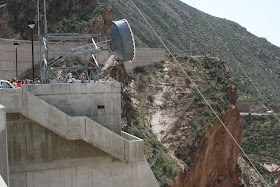Theodore Roosevelt Dam is a dam on the Salt River located northeast of Phoenix, Arizona. The dam is 357 feet (109 m) high and was built between 1905 and 1911, and renovated 1989 - 1996. The Dam is named after Theodore Roosevelt. The dam has a hydroelectric generating capacity of 36,000 kW. The dam forms the Theodore Roosevelt Lake as it impounds the Salt River.
Construction on Roosevelt Dam began in 1903 at the confluence of Tonto Creek and the Salt River. The primary purpose of the project was to provide water storage for the Salt River Project and flood control through the Salt River Valley. The dam was finished in 1911 after several devastating floods had interrupted the construction progress in 1905. At the time of completion in 1911, it was the largest masonry dam in the world with a height of 280 feet (84 m) and a length of 723 feet (216 m) while Roosevelt Lake was for a time the world's largest artificial reservoir. The dam was originally known as "Salt River Dam #1", it was not until 1959 that the dam and reservoir were officially named after Theodore Roosevelt.
In 1989, an ambitious expansion and renovation project was begun at Roosevelt Dam. The dam was resurfaced with concrete by J.A. Jones Construction Company, and its height was raised 77 feet (23 m) to 357 feet (107 m), which had the effect of increasing the storage capacity of Roosevelt Lake by roughly 20%. This project was completed in 1996 at a cost of $430 million. The $430 million in costs included three other major construction contracts associated with the dam. These included the realignment of Highway 188 over the new bridge up stream of the dam, renovations to the hydroelectric power plant, and a tunneling contract known as the "Lake Tap". The Lake Tap contract would provide locations where the penstocks would be located to bring water into the hydroelectric power plant. Shortly after completion, however, the area entered into a prolonged period of drought, and it would be some time before the newly increased capacity was put to use, with the lake finally reaching historic levels of 100% capacity in February 2009.
Smoke Stack
As a result of the reconstruction, the dam has a completely altered appearance from when it was originally listed as a National Historic Landmark. The original rubble-masonry dam was completely encased in concrete, and the structural height was extended from 280 feet (85 m) to 357 feet (109 m). Since the dam no longer had the integrity of the design, materials, workmanship, feeling, or association that it had when it was originally listed, the National Historic Landmark designation was withdrawn on March 10, 1999. The Theodore Roosevelt Dam National Register District contains other resources that are listed on the National Register of Historic Places, but the dam itself is no longer a contributing property to the district.
The photos above and below are the old level of the
dam and also the old road crossing the dam.
Roosevelt Lake Bridge
Prior to completion of the bridge in October 1990, traffic drove over the top of the dam. The bridge itself earned rare distinction when the bridge was named one of the top 12 bridges in the nation in November 1995. The American Consulting Engineers Council cited the bridge for overall design, size, eye-appeal and design challenge. Other bridges cited were the Golden Gate Bridge and Brooklyn Bridge
The $21.3 million bridge was built to take traffic off the top of Roosevelt Dam. Roosevelt Lake Bridge is the longest two-lane, single-span, steel-arch bridge in North America. The bridge, spans 1,080 feet across Roosevelt Lake providing two-way traffic. The original dam-top roadway was designed to allow two Model-T Fords to pass abreast, but today's recreational vehicles and full-size automobiles are too wide to permit two-way traffic.
Theodore Roosevelt speaking at the dedication ceremony in 1911.
Photo by Walter Lubken
Roosevelt Dam shortly after completion in 1911
Roosevelt Dam in 1915
Roosevelt Dam in 1996 after renovations were completed.




















































































